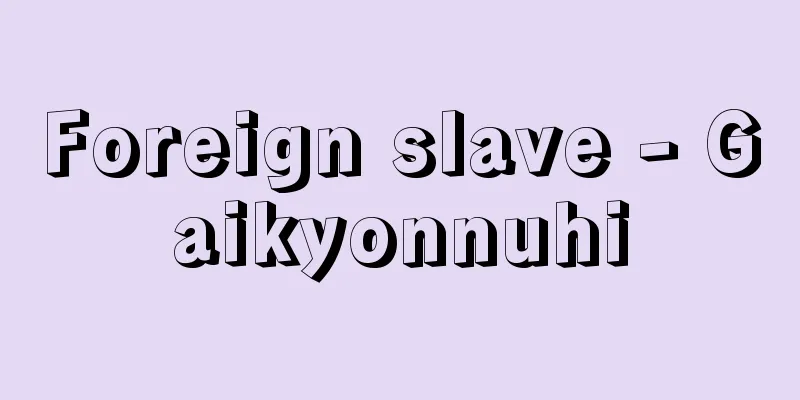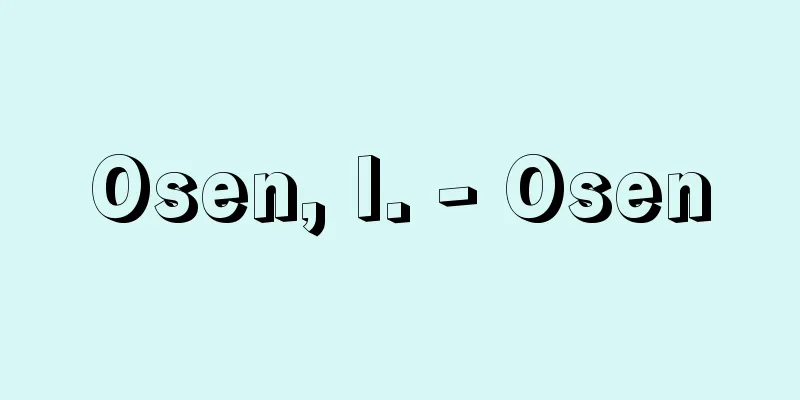Islamic Art

|
This refers to the arts and crafts produced over a period of about 1,100 years, from the 7th century to the 18th century, primarily in Western Asia and North Africa, the heart of the Islamic world. It progressed alongside the development of Islamic culture, but because it includes both secular and sacred content, it is different in nature from religious art such as Christian art or Buddhist art. [Mune Sugimura] Characteristics of Islamic artIslamic art absorbed cultures from various regions during its formation, but the art of Sassanid Persia and the ancient Mediterranean world was its foundation. This is why Islamic art has such diverse aspects. In Islam, a strict monotheistic religion, idolatry was thoroughly rejected. Moreover, because God is an invisible being, any representation of God was completely suppressed. Here, too, there is a difference between so-called religious art, which is based on the expression of religious icons, and Islamic art. The Holy Koran makes no mention of the nature or form of beauty, but the hadith (traditional sayings and deeds) of the Prophet Muhammad expresses a negative attitude toward the creation or ownership of statues and paintings that could be mistaken for idols. Although the interpretations of Islamic jurists and rulers regarding the plastic arts differed depending on the era and region, in general, abstract, conceptual, two-dimensional, and decorative expressions were preferred over concrete and realistic expressions. The so-called arabesque, which mainly consists of geometric patterns, stylized plant patterns, and Arabic letters, clearly shows the decorative orientation of Islamic art. Along with the above factors, one of the factors that promoted the uniformity of Islamic art was the Arabic language and Arabic script. In addition to its primary function of transmitting ideas, it also played a role in place of so-called religious iconography. This is suggested by the various inscriptions that decorate the interior walls of mosques. The second function was as a decorative element, and its widespread use is unparalleled. In Islam, God's revelation was given in Arabic and recorded in Arabic script. This is the holy book, the Quran, and this is why Arabic script is considered sacred. The reason why Arabic script was important as a decorative element is because the characters themselves are rhythmic and have beautiful, decorative shapes, and can freely express thick and thin lines, straight lines, and curves. It should also not be overlooked that the abstract shapes common to phonographic characters are easily harmonized with other highly abstract decorative elements such as geometric patterns and arabesques. Creative activity in the Islamic world took place at various levels, but it was almost always under the patronage of royal or aristocratic patrons, and was centered around royal court workshops, with many of the completed works strongly reflecting the tastes of their patrons. For this reason, Islamic art is often described as court art. The positioning of various fields in Islamic art differs from that of East Asian and European art, with calligraphy occupying the highest position, and since painting and sculpture were not well developed, crafts (metalwork, pottery, dyeing and weaving, glasswork, woodwork, etc.) being held in high regard. [Mune Sugimura] ArchitectureThe first unique religious building that comes to mind is the monumental Dome of the Rock (Jerusalem, 7th century). Like the Kaaba in Mecca, it contains a megalith, but its architecture is heavily influenced by Byzantium. Of the various forms of religious architecture, the most important is the mosque (masjid or ja'mi), a place of worship. In most cases, the back wall of the prayer hall has a mihrab, a niche representing the direction of Mecca (al-qibla). In addition, a throne-shaped pulpit (minbar) and a special seat for royalty (maqsura) are installed inside the mosque, and a tower minaret (manara) used to call on believers to participate in prayer, and a fountain for ablutions are often installed outside. There are three main types of mosques: (1) A hypostyle mosque developed mainly in Syria and Iraq, consisting of a courtyard surrounded by arcades on three sides and a prayer hall with a roof supported by many columns. This was modeled after the residence of the Prophet Muhammad, and there are examples in which a dome is symbolically placed on the main axis in front of the mihrab, such as the Umayyad Mosque in Damascus, Syria (established in 706) and the Great Mosque of Qairawan, Tunisia (established in 836). (2) A type in which an iwan, or a hall with an open front and tunnel-shaped vault, is located in the center of the four sides of the courtyard. This type is common in Iran, and is typified by the Masjid-i Camii in Isfahan (the main part dates back to the 11th century). (3) This type, which could be called a central synagogue type, was influenced by Byzantine architecture and was widespread throughout the Ottoman Empire. A large hall with large and small domes and a half dome is located adjacent to a slightly reduced courtyard. Examples include the Suleiman Mosque in Istanbul (1550-1557) designed by the famous architect Sinan, and the Mosque of Ahmed I (early 17th century). A madrasa usually consists of a courtyard surrounded by numerous private rooms, teaching spaces, and prayer rooms, and a typical example is Madrasa Mustansiriya in Baghdad (1233). In addition to sacred shrines for saints, mausoleums include those for royalty and nobility, and in Iran, the latter tend to have tall cylindrical towers, such as Gombadi Qabus (1007). The most representative form of secular architecture is the palace, which has traditionally been constructed with a central courtyard with a pond, fountain, and flower beds, and various public and private rooms built around it. Examples include Khirbat al-Mahjar in Jordan (740-750) and the Alhambra in Spain (13th-14th century). Caravanserai (caravan sarai, khan) have rooms (upper floor), storerooms, and shops arranged around a courtyard where horses and camels are kept, and some even have mosques, such as the Ribat-i-Sharaf in Iran (1114-1115). Fortresses (qasrs) began as models of the garrisons (limes) on the outskirts of the ancient Roman Empire. Examples of this are the rabats (ribats) that were placed on the periphery of the Islamic world. The magnificent citadel of Aleppo in Syria (11th to 13th centuries), with a moat surrounding the hills, is a good example of medieval Arab fortification techniques. Other known secular buildings include remains of hospitals, baths, monasteries, markets, and bridges. The materials used for the above-mentioned buildings were stone in the Western Islamic world, and mainly brick in the East. The architectural decorations are made of marble, tiles, and plaster, and feature arabesques, geometric patterns, and Arabic script. In all cases, there is a strong tendency to prioritize decorative effect over structural and functional aspects, which results in the loss of the original character of the building. [Mune Sugimura] PaintingIslamic painting has two distinct styles: murals, which developed as decorations for the palaces of the caliphs, and hand-drawn illustrations in manuscripts (miniatures), which developed in the 11th and 12th centuries in response to the spread of papermaking techniques. Well-known murals include those at Qasr al-Hayl al-Gharbi (8th century) in Syria and the Chehel Sutun Palace in Isfahan (17th century). The first illustrated manuscripts were attached to Arabic translations of Greek scientific and technical books in booklet format, and later illustrations for historical and literary works became more important. It was only in the early modern period that standalone works such as portraits and illustrated booklets were produced. Most manuscripts were produced in workshops directly under the imperial court, by calligraphers, painters, illustrators, foil-makers and book-binders. The painters' interests were focused on increasing decorative effects and creating patterns in compositions, and they showed little interest in individual expression, the expression of emotion, perspective or shading. [Mune Sugimura] Persian paintingPersian painting is characterized by its lyricism, refined sense of color, and advanced technique. Before the Mongol period, masterpieces of illuminated manuscripts such as Warqa and Gulshah (13th century) were produced, and during the Mongol period, masterpieces of illuminated manuscripts such as Rashid al-Din's Jami al-Tawarihi (Collected Histories) (1307 and 1314), which shows the influence of Chinese Song and Yuan painting, and Firdousi's heroic epic poem Shahnameh (Book of Kings) (1010) were produced. The Timurid dynasty was the heyday of Persian painting, and illuminated manuscripts such as Nizami's "Pentalogy" (Khamseh) (late 12th century) were produced (1494), which added decorativeness and intricacy, mainly in Herat and Shiraz. The painter Bikhizad perfected the traditional technique and paved the way for portraits and genre painting. The Safavid school of painters under Rizal Abbasi further developed this style and left behind excellent examples of line drawing. However, the rapid Westernization and loss of ancient traditions in the second half of the 17th century marked the end of Persian painting. [Mune Sugimura] Arab paintingAlready in the 12th century, the Mesopotamian school, the first Arab school of painting, was actively producing works in Baghdad, Mosul, Basra, and other places. The oldest surviving example is an 11th-century illustration (line drawing) for Kitab Suwar al-Kawaqib (Deixis). Representative works include illustrations for Materia Medica (Medicine), the fable Kalila and Dimna, and the adventure story Maqamat (The Assembly) by Hariri (all 13th century). The latter was painted by Yahya al-Wasite, and is important in that, unlike the traditional imperial themes, it depicts urban life of the time in detail. The Mamluk dynasty (Egypt, Syria) followed the Mesopotamian tradition in both theme and style, but there was a marked trend toward typification of images, abstraction of various elements, and decorativeness. [Mune Sugimura] Turkish paintingFrom the 15th century under the rule of the Ottoman Empire, illustrations for manuscripts with a strong Persian character were produced, but in the 16th century, a style unique to Turkey was formed. In contrast to Persian paintings, which are strongly lyrical, Ottoman paintings are more realistic, and many of their themes are based on historical facts. Works such as "Süleymannameh", "Zubdat Tawalihi (Essence of History)", and "Surnameh (Book of Rites)" (all from the 16th century) are characterized by simple, uniform composition and stiff images. Portraits of sultans were also frequently painted. In Turkey, which had frequent exchanges with Europe from an early stage, the traditional arts were already in severe decline by the beginning of the 17th century, and Turkish painting was inevitably forced to follow the same path of decline as Persian painting. [Mune Sugimura] CraftsIn the Islamic world, where the free development of painting and sculpture was suppressed, artists' creative enthusiasm was concentrated solely on crafts and decoration. Therefore, the significance of crafts there is much greater than in East Asia or Europe. Among them, metal crafts occupy a position of greatest importance along with ceramics and dyeing and weaving. One common characteristic of crafts is that, as with architectural decoration, excessive decoration significantly impairs the original functionality and texture of the objects. [Mune Sugimura] Metal craftsA wide variety of items, including candlesticks, incense burners, pitchers, and pen cases, were made using bronze, brass, gold, silver, copper, and iron, as well as casting, hammering, engraving, inlay, plating, gold leaf, and openwork techniques. Gold, silver, and copper were used for inlay, and the type of inlay made of iron or steel weapons and armor with gold or silver wire is known as Damasquin. The origins of Islamic metalwork lie in Sassanid Persia and Byzantium. Many so-called "post-Sasanian" works remain in the eastern Islamic world (Tabalistan and Khorasan in Iran), while there are few early works from the western Islamic world. The technique of silver inlay was popular from the heyday of the Seljuk Dynasty through the Mongol period, and continued until the 16th and 17th centuries. The center of this movement gradually shifted westward, and Mosul in Iraq, followed by Damascus and Cairo, became the major production centers. In Persia, representational hunting scenes and bird and animal paintings were popular, while in Syria and Egypt, abstract designs such as arabesques and inscriptions were popular. [Mune Sugimura] TextilesBoth the techniques and designs were inherited from the Sassanid Persian and Byzantine traditions. In addition to patterns, tapestries, brocades, and velvets, embroidery was also popular. Arabesque, geometric, and bird and animal designs were popular decorations, and Arabic inscriptions were also indispensable decorative elements. Tiraz, a royal textile workshop dating back to the 8th century, was established not only in Egypt but also in other parts of the country later. Linens were produced here, especially the kirat (high garments) bestowed by the caliph to his subjects as rewards for distinguished service. Carpets occupy the most important position in Islamic dyeing and weaving. Among the various pile-woven carpets, Persian carpets are by far the most important in terms of both quality and quantity, followed by those from Turkey and Central Asia. Pile-woven carpets are made on a vertical or horizontal loom, and are characterized by tying colored threads to the warp threads to create patterns. There are two types of knots: Persian and Turkish. Depending on the decoration, they can be classified into types such as medallion, geometric, arabesque, vase design, garden design, hunting design, bird and animal design, sacred tree design, and arch (for prayer). [Mune Sugimura] GlassIt inherited the glass traditions of ancient Rome and Sassanid Persia. From the 8th to the 11th centuries, relief, engraving and cut techniques were popular mainly in Persia and Mesopotamia, while from the 12th to the 14th centuries, colorful enamel painting techniques became popular along the Mediterranean coast, especially in Syria and Egypt. Forms unique to Islamic glass include mosque lamps, various rose water jars and flat pilgrim jars. [Mune Sugimura] Ivory carvingIt has been a long tradition dating back to ancient times, but during the Islamic period, the main production areas were Syria, Egypt, Spain, and southern Italy along the Mediterranean coast. Small boxes, horns, pieces for games such as chess, combs, and accessories were made, with arabesques, bird and animal designs, hunting scenes, and other motifs carved in relief on these objects. Most of the surviving relics were made between the 11th and 13th centuries, primarily in the Western Islamic world. [Mune Sugimura] PotteryWestern Asia, along with China, is one of the two major pottery-producing regions, and has a track record of pioneering the development of glazed pottery technology. As the birthplace of ancient civilization, this region has also made groundbreaking inventions in the field of glazed pottery, with the polychrome glazed pottery of the Achaemenid Empire being particularly famous. The tradition of glazed pottery continued after that, but after the rise of Islam and the creation of a new culture, new kilns began to take shape throughout Western Asia and Egypt from around the 9th century. This period marked the dawn of Islamic pottery. This new form of pottery was heavily influenced by Chinese ceramics, which began to be imported in large quantities based on the pottery-making activities of Sassanid Persia and Byzantium, and there is no doubt that this was a major stimulus. In the case of Sancai, which combines various colored glazes using lead glazes, and opaque white glazes using tin as a solvent, the shapes and designs are overwhelmingly modeled on Chinese ceramics of the 9th and 10th centuries.However, the originality typical of Islamic ceramics was already apparent at this stage, with free and open line patterns added by applying white makeup to a yellowish brown base, copper luster glazes, and underglaze painting with cobalt pigments, which were the origins of later blue and white porcelain. From the 11th to the 15th centuries, Islamic pottery was at its most developed and bountiful. Chinese ceramics were still the main prototype, but the style showed a diverse development. The colorful tri-color disappeared, and clear monochromatic glazes of blue, indigo, and white became the norm, and the decorative techniques were also extremely complex. The blue glaze of Turkish blue is a typical example, and copper carbonate was used as the coloring agent. The decorative techniques are extremely diverse, including the blue and white porcelain and luster glaze from the previous era, the Gabri style with its scratched patterns, the Rakabi style with its colorful patterns, the Minai style with its painting on the white glaze, the Rajberdina style with its overglaze painting on a blue and indigo glaze, and the white glaze with its overglaze painting and then a transparent glaze applied again, giving the impression of a profusion of flowers. After the fall of the Ilkhanate at the end of the 14th century, pottery production generally declined for a time, but with the rise of the Safavid dynasty and the rise of the Persian Empire in Iran in the 16th century, pottery production was revived and old traditions were revived. However, the originality was still in the imitation of blue and white porcelain made in China during the Ming dynasty. Meshed kilns in Iran and Iznik kilns in Turkey are famous, but neither are porcelain, but rather are made of a ceramic or semi-porcelain base, which gives them a soft and unique style. Among them, bright and elegant colored pottery, in which patterns are painted under a transparent glaze using various colored paints, is commonly known as Kubachi and is highly valued. It is believed to have been fired in the Azerbaijan area in western Iran. [Yoshiaki Yabe] "Grand World Art 8: Islamic Art" edited by Shinobu Iwamura (1976, Kodansha)" ▽ "World Art Series 8: Islamic Art" edited by Shinji Fukai (1976, Gakken)" ▽ "Islamic Painting - The Topkapı Sarai Collection" commented by E. J. Grube and translated by Mune Sugimura (1978, Heibonsha)" ▽ "Great View of Western Ceramics 4: Islamic Ceramics" by R. J. Charleston and translated by Mune Sugimura (1979, Kodansha)" ▽ "Complete Collection of Metropolitan Art 10: Islam" by the Metropolitan Museum of Art (1991, Fukutake Shoten)" ▽ "The Voice of Things: The Poetry of Painting - Arabic and Persian Literature and Islamic Art" by Hideaki Sugita (1993, Heibonsha)" ▽ "Complete Collection of World Art 17: Islam" (1999, Shogakukan)" ▽ "Iwanami World Art: Islamic Art" by Jonathan Bloom and Sheila Blair, translated by Tomoko Masuya (2001, Iwanami Shoten) [References] | | | |Alhambra| | | | | | | | | | | |Source: Shogakukan Encyclopedia Nipponica About Encyclopedia Nipponica Information | Legend |
|
7世紀から18世紀までの約1100年の間に、イスラム世界の中心である西アジア、北アフリカを主要な舞台としてつくりだされた美術工芸全般をさす。それは、イスラム文化の発展と歩みをともにしているが、聖俗両面にわたる内容を含んでいるため、キリスト教美術、仏教美術などの宗教美術とは性格を異にする。 [杉村 棟] イスラム美術の特質イスラム美術は、その形成過程で各地の文化を吸収したが、なかでもササン朝ペルシアと古代地中海世界の美術が基礎となった。イスラム美術が多様な一面をもつのは、このような理由による。 厳格な一神教であるイスラム教では、偶像崇拝が徹底して排斥された。しかも、神は不可視的な存在であるから、神の具象的表現は完全に抑制された。宗教図像の表現を基本とするいわゆる宗教美術とイスラム美術との違いがここにもある。聖典コーランは、美の本質や造形についてなにも言及していないが、預言者ムハンマド(マホメット)の言行伝承録(ハディース)は、偶像と紛らわしい彫像・絵画の制作、あるいはその所有に対しても、否定的態度を表明している。造形芸術に関するイスラム法学者や支配者の解釈は、時代、地域によって異なるとはいえ、一般に、具象的・写実的表現よりも、抽象的・観念的・二次元的・装飾的表現が好まれた。幾何文、様式化した植物文、アラビア文字などを主要な構成要素とするいわゆるアラベスクは、このようなイスラム美術の装飾志向を端的に示すものである。 以上の諸要素とともに、イスラム美術の画一性を助長した要因の一つは、アラビア語とアラビア文字である。それは思想の伝達という第一義的な機能のほかに、いわゆる宗教図像にかわる役割を果たした。モスクの内壁を飾る種々の銘文がそれを示唆している。第二は装飾要素としての機能で、その広範な使用は他に類をみない。イスラム教における神の啓示は、アラビア語で下され、アラビア文字で記録された。これが聖典コーランであり、アラビア文字が神聖視されるゆえんはここにある。アラビア文字が装飾要素として重きをなしたのは、文字そのものがリズミカルで、装飾性に富む美しい形をしているからであり、肥痩(ひそう)、直線、曲線を自由自在に表すことができるからでもある。また表音文字に共通した抽象的な形体が、幾何文、アラベスクなど他の抽象性の強い装飾要素と調和しやすいことも見逃してはならない。 イスラム世界における創作活動はさまざまなレベルで行われていたが、とくに、ほとんどいつの時代にもパトロンである王侯貴族の保護を受け、宮廷工房を中心に行われ、完成された多くの作品はパトロンの趣味を強く反映していた。このためにイスラム美術は、しばしば宮廷美術として説明される。 イスラム美術における諸分野の位置づけは、東アジアやヨーロッパの美術のそれと異なり、書道がもっとも高い位置を占め、いわゆる絵画、彫刻が発達しなかったこともあって、工芸(金工、陶器、染織、ガラス、木工など)がこれに次いで高い評価を得ていた。 [杉村 棟] 建築異色ある宗教建築としてまずあげられるのは、記念碑的役割を果たした「岩のドーム」(エルサレム、7世紀)である。メッカのカーバ神殿と同様に巨石が納められているが、建築的にはビザンティンの影響が大きい。宗教建築の諸形式のなかでは、礼拝所モスク(マスジッドまたはジャーミー)がもっとも重要である。礼拝堂の奥壁には、ほとんどの場合メッカの方角(アル・キブラ)の表象である壁龕(へきがん)(ミフラーブ)が設けられる。そのほか、玉座をかたどった説教壇(ミンバル)、王侯のための特別席(マクスーラ)がモスクの内部に設けられ、信徒に祈祷(きとう)への参加を呼びかけるために使われる塔ミナレット(マナーラ)、潔斎のための泉亭が外部に設置されることが多い。 モスクには主として三つのタイプがある。 (1)シリア、イラクを中心に発達した多柱式で、アーケードを三方に巡らした中庭と、多数の柱が屋根を支えている礼拝堂からなる。これは預言者ムハンマドの住まいをモデルにしたもので、ミヒラーブ前方の主軸上に、象徴的にドームを架けた例もあり、シリアのダマスカスのウマイヤ・モスク(706創設)やチュニジアのカイラワーンの大モスク(836創設)がこれにあたる。 (2)イーワーン、つまりトンネル形の穹窿(きゅうりゅう)(ボールト)を架けた前方開放式のホールを中庭の4辺の中央に設けたタイプ。これはイランに多く、イスファハーンのマスジッド・イ・ジャーミー(主要部は11世紀)に代表される。 (3)ビザンティン建築の影響による中央会堂式ともいうべきタイプで、オスマン帝国領内で普及した。やや縮小された中庭に隣接して、大小のドーム、半ドームを架けた大ホールが配置されている。著名な建築家スィナンによるイスタンブールのスレイマン・モスク(1550~1557)、あるいはアフメト1世のモスク(17世紀初期)などがある。 学林(マドラサ)は通常、中庭を多数の個室と教場、礼拝室などが取り囲む構成をとり、その典型的な例はバグダードのマドラサ・ムスタンスィリーア(1233)にみられる。墓廟(ぼびょう)には、聖者を葬った聖廟のほか、王侯貴族を葬った廟があり、イランではゴンバディ・カーブース(1007)のように、後者に円筒状の高い塔を有する傾向がある。 世俗建築の代表的な形式は宮殿で、中央に池、噴水、花壇などを設けた中庭を中核として、周囲に公私の各種の部屋を建てる構成が伝統的にとられてきた。ヨルダンのヒルバト・ル・マフジャール(740~750)、スペインのアルハンブラ宮殿(13~14世紀)などがある。隊商宿(キャラバン・サライ、ハーン)は、ウマやラクダを置く中庭の周囲に客室(階上)、倉庫、店舗を配置し、なかにはイランのリバート・イ・シャラフ(1114~1115)のようにモスクを設けた例もある。城砦(じょうさい)(カスル)は、古代ローマ帝国の辺境の駐屯所(リメス)を範としてスタートした。イスラム世界の周辺に配置されたラバート(リバート)がこれにあたる。丘陵の周囲に堀を巡らしたシリアのアレッポの壮大な城砦(11~13世紀)は、中世アラブの築城法を示すよい例である。世俗建築としてはこのほかに病院、浴場、修道場、市場、橋梁(きょうりょう)の遺構が知られている。以上に述べた建物の材料は、西方イスラム世界では石材が、また東方ではおもにれんがが使われている。 建築装飾には、大理石、タイル、漆食(しっくい)などが使われ、アラベスク、幾何文、アラビア文字が表されている。いずれの場合にも、構築性、機能性よりも、装飾効果をつねに優先させる傾向が強く、その結果、建築物本来の性格が損なわれてしまう。 [杉村 棟] 絵画イスラム絵画には、カリフの諸宮殿の装飾として発達した壁画と、11、12世紀ごろから製紙法の伝播(でんぱ)に呼応して発達した、手書きの写本挿絵(ミニアチュール)という独特の形式の2形式がある。壁画では、シリアのカスル・アル・ハイル・アル・ガルビ(8世紀)や、イスファハーンのチェヘル・ストゥーン宮(17世紀)のものなどが知られている。 写本挿絵は、ギリシアの自然科学書、技術書のアラビア語訳の冊子形式の写本に付されたのが最初で、のちには史書や文学書の挿絵が重きをなした。肖像画や画冊など単独の作品は近世に入って初めて制作された。写本は、その多くが宮廷直属の工房における書家、絵師、彩飾師、箔置(はくおき)師、装丁師らの工房制作である。絵師の関心は装飾効果の増大、構図のパターン化などに集中し、個性的表現、感情表出、遠近法、陰影法にはほとんど興味を示していない。 [杉村 棟] ペルシアの絵画ペルシア絵画の特徴としては、抒情(じょじょう)性、洗練された色彩感覚、高度の技法などをあげることができる。モンゴル時代以前には『ワルカとグルシャー』(13世紀)、モンゴル時代には、中国の宋(そう)・元(げん)の絵画の影響を示すラシード・ウッディーンの『ジャーミ・アッタワーリーヒ(集史)』(1307および1314)やフィルドウスィーの英雄叙事詩『シャー・ナーメ(王書)』(1010)などの装飾写本の傑作がつくられた。ティームール朝はペルシア絵画の隆盛期で、ヘラートやシーラーズを中心に、装飾性と緻密(ちみつ)さを加えたニザーミーの『「五部作」(ハムセ)』(12世紀後半)などの装飾写本が制作された(1494)。絵師ビヒザードが伝統的手法を完成し、新たに肖像画や風俗画への道を開いた。さらに、サファビー朝のリザー・イ・アッバースィー一派は、これをいっそう発展させるとともに、優れた線描画を残している。しかし、17世紀後半における急速な西欧化と古来の伝統の喪失は、ペルシア絵画の終焉(しゅうえん)を意味した。 [杉村 棟] アラブの絵画すでに12世紀ごろのバグダード、モスル、バスラなどで、アラブ最初の画派であるメソポタミア派が活発な制作活動をしていた。現存する最古の作例は『キターブ・スワル・アル・カワーキブ(恒星論)』の11世紀の挿絵(線描画)である。代表作として『マテリア・メディカ(薬物誌)』、寓話(ぐうわ)『カリーラとディムナ』、ハリーリーによる冒険譚(たん)『マカーマート(集会)』(以上13世紀)などの挿絵がある。後者はヤヒャー・アル・ワースィティーの筆になり、従来の帝王主題と異なって、当時の都市生活をつぶさに描き出している点で重要である。マムルーク朝(エジプト、シリア)には、主題、様式ともにメソポタミアの伝統が踏襲されたが、図像の類型化、諸要素の抽象化、装飾化が著しい。 [杉村 棟] トルコの絵画15世紀ごろからオスマン帝国の支配下で、ペルシア的性格の濃厚な写本挿絵が描かれたが、16世紀に入ってトルコ独自の様式が形成されていった。抒情性の強いペルシア絵画とは対照的に、オスマン帝国の絵画は現実性が強く、主題も史実に基づいたものが少なくない。『スレイマーン・ナーメ』『ズブダトッ・タワーリーヒ(歴史精髄)』『スル・ナーメ(祭典の書)』(以上16世紀)などでは、単純で画一的な画面構成と生硬な図像が特色となっている。また、スルタンたちの肖像画も盛んに描かれた。早くからヨーロッパとの交渉が頻繁だったトルコでは、すでに17世紀初頭において伝統芸術の衰退が甚だしく、トルコ絵画もペルシア絵画と同じ凋落(ちょうらく)の道をたどらざるをえなかった。 [杉村 棟] 工芸いわゆる絵画、彫刻の自由な発達が抑えられてきたイスラム世界では、芸術家の創作意欲はひたすら工芸や装飾に注がれた。したがってそこでは、工芸のもつ意味は、東アジアやヨーロッパよりもはるかに大きい。そのなかでも金属工芸は、陶芸、染織とともにもっとも重要な位置を占める。工芸諸分野における共通した特質の一つは、建築装飾と同様、過剰な装飾を施すことにより、器物本来の機能性や質感などが著しく損なわれていることである。 [杉村 棟] 金属工芸青銅、真鍮(しんちゅう)のほか、金、銀、銅、鉄を素材とし、鋳造、打ち出し、彫金、象眼(ぞうがん)、めっき、金箔(きんぱく)、透(すかし)彫りなどの技法によって、燭台(しょくだい)、香炉、水差し、ペンケースなど多様な作品がつくられた。象眼には、金、銀、銅が使われ、とくに鉄、鋼鉄製の武器・武具に金線や銀線で象眼を施したタイプは、ダマスコ細工(ダマスキーン)として知られている。イスラム金工の淵源(えんげん)はササン朝ペルシアとビザンティンにある。東方イスラム世界(イランのタバリスターン、ホラサーン)には、いわゆる「ポスト・ササン」の作品が数多く残存しているのに対し、西方イスラム世界の初期の作品は少ない。最盛期のセルジューク朝からモンゴル時代にかけて銀象眼の技法が流行し、16、17世紀まで続いた。その中心はしだいに西漸し、イラクのモスル、続いてダマスカスとカイロが有力な製作地となった。ペルシアでは具象的な狩猟図、鳥獣図などが、またシリア、エジプトではアラベスク、銘文など抽象的なデザインが盛行した。 [杉村 棟] 染織技法、デザインともにササン朝ペルシアとビザンティンの伝統を引き継いだ。紋織、綴(つづれ)織、錦(にしき)、ビロードなどのほか、刺しゅうも盛んに行われた。装飾としては、アラベスク、幾何文、鳥獣文が好まれ、アラビア語の銘文も欠かせない装飾要素であった。8世紀にさかのぼる王室直属の織物工房ティラーズは、エジプトのみならず、のちに各地に設置された。ここではリンネル類がつくられたが、とくに論功行賞としてカリフから臣下に下賜された上衣(ヒラート)が織られている。イスラムの染織のなかでもっとも重要な位置を占めるのは、じゅうたんである。各種のパイル織じゅうたんのなかで、ペルシアじゅうたんが質量ともに群を抜き、トルコと中央アジア諸地域のものがこれに続く。パイル織じゅうたんには、竪機(たてばた)か水平機が使われ、経(たて)糸に文様となる色糸を結ぶのを特色とする。結び方にはペルシア結びとトルコ結びがある。装飾によって、メダイオン、幾何文、アラベスク、花瓶文、庭園文、狩猟文、鳥獣文、聖樹文、アーチ(祈祷(きとう)用)などのタイプに分類することができる。 [杉村 棟] ガラス古代ローマとササン朝ペルシアのガラスの伝統を継承している。8~11世紀には、おもにペルシアやメソポタミアで、浮彫り、線彫りやカット技法が盛行し、一方、12~14世紀には、地中海沿岸地方、とくにシリア、エジプトで多彩なエナメル彩画の技法が新たに流行した。イスラム・ガラス独特の形式としては、モスク・ランプ、各種のバラ水瓶、扁壺(へんこ)形巡礼瓶などがある。 [杉村 棟] 象牙細工古代から長い伝統が踏襲されてきたが、イスラム時代には地中海沿岸のシリア、エジプト、スペイン、南イタリアがおもな製作地となった。小箱、角笛、チェスなどのゲームの駒(こま)、櫛(くし)のほか装身具類がつくられ、これに浮彫りでアラベスク、鳥獣図、狩猟図などが表現された。現存する遺品は、大半が11世紀から13世紀の間にもっぱら西方イスラム世界で製作されたものである。 [杉村 棟] 陶器西アジアは中国と並ぶ二大製陶地であり、施釉陶(せゆうとう)の技術を世界に先駆けて開発くふうした実績がある。古代文明の発祥の地であるこの地方は施釉陶器の面でも画期的な発明を行っており、アケメネス朝ペルシアの多彩釉陶はことに名高い。その後も施釉陶の伝統は続いたが、イスラム教が勃興(ぼっこう)して清新な文化が生み出されたのち、9世紀ごろから西アジア~エジプト各地に新窯の胎動が始まった。この時期がイスラム陶器の黎明(れいめい)期である。この新しい焼物作りにはササン朝ペルシアやビザンティンの製陶活動を基礎にして、多量に輸入され始めた中国陶磁の影響が色濃く反映しており、大きな刺激となったことは疑いない。鉛釉を使った各種の色釉をかけあわせた三彩、錫(すず)を溶媒剤に使った失透性の白釉では、その形や文様は明らかに9~10世紀の中国陶磁を手本としたものが圧倒的に多い。ただ、黄褐色の素地に白化粧して自由闊達(かったつ)な線描の文様を加えたり、銅によるラスター彩、コバルト顔料で下絵付して後の染付の始原をなすなど、すでにこの段階でイスラム陶らしい斬新(ざんしん)な創意が示されている。 11世紀から15世紀にかけてイスラム陶器はもっとも発達し、豊富な実りがもたらされた。やはり中国陶磁が重要な祖型となっているが、作風は多様な展開を示している。色彩豊かな三彩が消え、青、藍(あい)、白などの明晰(めいせき)な単色釉が主となり、装飾技法もすこぶる複雑である。トルコ・ブルーの青釉はその典型で、呈色剤には炭酸銅が用いられた。前代からの染付やラスター彩、掻(か)き落し文様のガブリ手、色彩で文様を表したラカビ手、白釉面に絵付したミナイ手、青藍(せいらん)釉地に上絵付したラジュベルディナ手、白釉面に上絵付して再度透明釉をかけた白釉藍黒彩陶など加飾法はきわめて多彩で、百花繚乱(りょうらん)の感がある。14世紀の終わりにイル・ハン国が倒れたのち、一時期、作陶は総体に低調であったが、16世紀のイランにサファビー朝が興り、ペルシア人による帝国が興ると、製陶も復活して旧来の伝統がよみがえった。しかし新味はやはり明(みん)代中国製の染付磁器の模倣にあった。イランのメシェッドやトルコのイズニーク窯が名高いが、いずれも磁器ではなく、陶胎か半磁胎で柔らかく、独特の風韻(ふういん)がある。なかでも各種の色絵の具を使って文様を透明釉下に描いた明るく温雅な色絵陶器は、俗にクバチとよばれて珍重されている。これはイラン西部のアゼルバイジャン方面で焼造されたものと推測されている。 [矢部良明] 『岩村忍編『グランド世界美術8 イスラムの美術』(1976・講談社)』▽『深井晋司編『大系世界の美術8 イスラーム美術』(1976・学習研究社)』▽『E・J・グルーベ解説、杉村棟訳『イスラムの絵画――トプカプ・サライ・コレクション』(1978・平凡社)』▽『R・J・チャールストン著、杉村棟訳『西洋陶磁大観4 イスラム陶器』(1979・講談社)』▽『メトロポリタン美術館著『メトロポリタン美術全集10 イスラム』(1991・福武書店)』▽『杉田英明著『事物の声 絵画の詩――アラブ・ペルシア文学とイスラム美術』(1993・平凡社)』▽『『世界美術大全集17 イスラーム』(1999・小学館)』▽『ジョナサン・ブルーム、シーラ・ブレア著、桝屋友子訳『岩波世界の美術 イスラーム美術』(2001・岩波書店)』 [参照項目] | | | | | | | | | | | | | | | | |出典 小学館 日本大百科全書(ニッポニカ)日本大百科全書(ニッポニカ)について 情報 | 凡例 |
<<: Islamic Revival Movement - Islamic Revival Movement
>>: Islamic League - Islamic League
Recommend
Shio-jiru - Ushio-jiru
It is a clear soup made with fresh fish and shell...
Kirishima Rokusho Gongen
...Seiku is known for visiting various mountains ...
Signal - shingou (English spelling) signal
A method of communicating between two people who ...
"Izumo no Kuni Fudoki"
…The legend of the origin of the place name “Ou” ...
globus pallidum (English spelling) globuspallidum
…In this section, I would like to explain along t...
Collection of houses - Ienoshu
A personal collection of poems. Kashu (family anth...
"The Art of Drama"
…F. Hebbel tried to support tragedy by incorporat...
Omoto Kagura - Omoto Kagura
This is a type of Kagura dance performed in the O...
Fiji - Republic of Fiji (English spelling)
An island nation located in eastern Melanesia in ...
Homalomena (English spelling)
A plant of the Araceae family, with about 50 speci...
Shark fin - Shark fin
It is an ingredient in Chinese cuisine, and is the...
Kikuchi River
A river that flows through northern Kumamoto Pref...
Gas station
…Gas stations primarily fill automobiles with gas...
School myopia - gakkokinshi
This is myopia that begins around the age of ente...
sheath knife
…Knives as tools are diverse in both function and...









